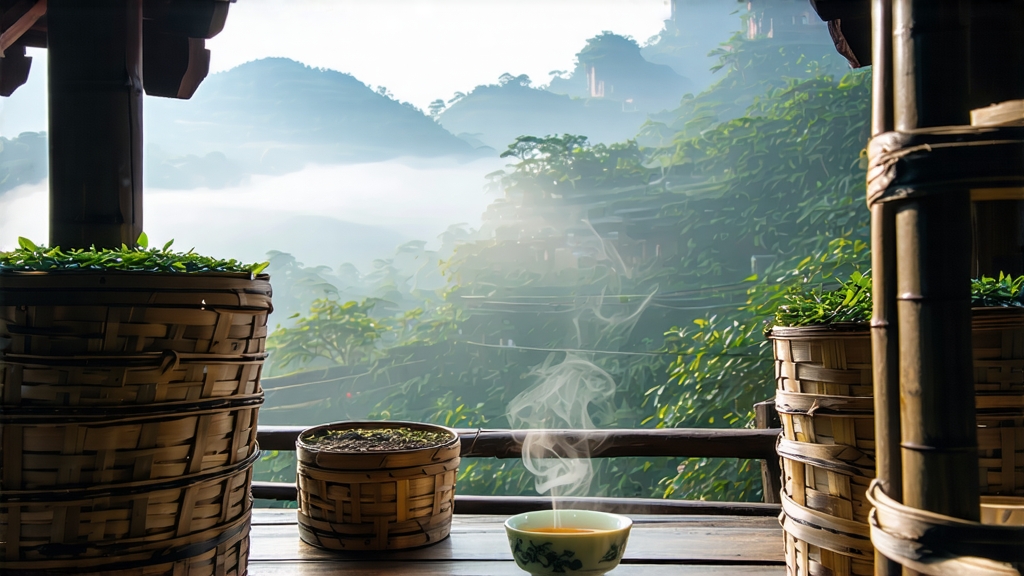
Liu Bao—pronounced “lee-ow bao”—is the quiet diplomat of China’s dark-tea family. While Pu-erh grabs headlines, this Guangxi native has spent four centuries smoothing its edges in dim caves, bamboo baskets, and the cargo holds of junks that once sailed the Grand Canal to Southeast Asia. One sip and you taste history: the humid breath of subtropical mountains, the mineral bite of limestone rivers, and the sweet, almost betel-nut fragrance that earned it the nickname “the tea that sailors chewed.”
-
From Frontier Herb to Maritime Currency
The story begins in the dense foothills of Wuzhou County during the late Ming dynasty. Caravans carrying salt, copper, and medicinal herbs needed a light-weight, non-perishable beverage to barter with Yao and Zhuang minorities. Sun-dried, loosely compressed tea tolerated the drenching heat of the South; the darker it turned, the more valuable it became. By the Qing, Liu Bao bricks were legal tender in parts of Guangdong, used to pay dockworkers and even taxes. When British and Dutch clipper ships arrived, they mistook the glossy black leaves for another exotic spice, stacking them beside nutmeg and pepper in Batavia’s warehouses. There, the tea absorbed ambient aromas, accidentally inventing the “boat-aged” profile that connoisseurs still prize. -
Terroir: Where Rocks Breathe Mist
Authentic Liu Bao grows between 200–600 m on red lateritic soil shot through with limestone shards. The karst topography funnels cool night air into narrow valleys, forming morning fogs that act like a natural shade cloth. This slows photosynthesis, boosting theanine and poly-phenol complexes that later mutate into dark tea’s signature chestnut sweetness. Indigenous medium-leaf cultivars—Da Ye Zhong and Bai Hao Zao—have thicker cuticles than Yunnan’s broad-leaf assamica, allowing repeated wok-firing without burning the leaf spine. -
Craft: The Rhythm of Water, Heat, and Microbes
Unlike Pu-erh’s sun fixation, Liu Bao undergoes “water retting” (渥堆, wo dui) inside bamboo rooms perched over simmering kettles. The process is choreographed in three acts:
Act I – Sha Qing (Kill-Green): Leaves are tumble-fried at 280 °C for ninety seconds, hot enough to blister the epidermis yet preserve internal enzymes.
Act II – Shui Re Dui (Wet-Heat Pile): The semi-dry leaf is sprayed with mineral-rich spring water, stacked 70 cm high, and covered with jute sacks. Internal temperatures climb to 55 °C within 24 hours; thermophilic fungi Aspergillus niger and Blastobotrys proliferate, oxidizing catechins into theabrownins that tint the liquor maroon. Every twelve hours the pile is turned by barefoot workers who read the aroma like sheet music: wet hay signals oxygen debt, dried longan means proceed.
Act III – Song Yan (Pine-Basket Roast): The tea is re-dried in baskets suspended above smoldering pine embers for three hours. Volatile pinene and resin penetrate the leaf, locking in a camphor note that later mellows into sandalwood.
-
Shapes of Time: Loose, Basket, Brick, Coin
After firing, the leaf may be sold as loose maocha, but most is packed into 40 kg bamboo husks called lang. A lang is lined with wild banana leaf, steam-softened, then pounded with wooden mallets until the tea fuses into a dense cake. The bamboo breathes, allowing micro-oxidation while repelling insects. A decade later the cake is pried apart, revealing amber veins that resemble agate. Smaller 100 g “coin bricks” stamped with the character 寿 (longevity) were once pocket money for coolies; today they are collector items that fetch four-figure sums at Hong Kong auctions. -
Brewing: The Gongfu of Patience
Liu Bao forgons the flashy theatrics of green tea; it rewards restraint. A 120 ml Yixing pot seasoned solely with dark teas is ideal. Begin by rinsing 6 g of leaf for ten seconds with 95 °C water—just enough to wake the dormant spores. Discard the rinse and inhale the lid: you should catch a whiff of petrichor